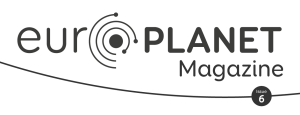The Making of ‘The Making of Juice’
Maarten Roos-Serote (Lightcurve Films, Portugal) shares a unique view behind the scenes of the development of a space mission.
Read article in the fully formatted PDF of the Europlanet Magazine.
I started my filmmaking career in 2006 with a short promotional video for my first customer – Europlanet.
My second production (2007) was a series of four educational videos about Venus research for the Venus Express mission at ESA. At that moment, the idea took hold in my mind for a documentary film telling the story of the process of putting together a space exploration mission. In the intervening years, I suggested it to people at ESA several times, but found no real interest.
I did, however, in 2010 get a chance to produce a short behind-the-scenes documentary film (sponsored by the Paris Observatory, the French CNRS and the Italian Space Agency) about the VIRTIS instrument, which was flying both on the Rosetta and Venus Express missions.
In late 2019, the Juice Project Scientist, Olivier Witasse, invited me for a coffee at Leiden Central Station. The Juice team at ESA had a wish to create a documentary film about the making of Juice. The industrial phase of the Juice project started in 2015. The idea for the film would be to follow the second part of the integration activities of the spacecraft right up until lift-off to Jupiter. Though, of course, the science and technology would provide an important backbone for the film, the emphasis would be mostly on the human story behind the project. The aim would be to feature the actual people who were putting the machine together and highlight the incredible collaboration necessary to get the first European mission to Jupiter off the launch pad. Needless to say, I jumped at this opportunity! For me personally, it felt like a circle closing, as my planetary science career had begun in 1991 with the Galileo mission to Jupiter.
Filming started in late February 2020 at ESA/ESTEC in Noordwijk. I interviewed the Juice Project Manager, Giuseppe Sarri, and Olivier Witasse. These were introductory interviews talking about the Juice project in general, the current status and the background. Launch was still foreseen for May 2022 – at that time, the most optimal launch window that would get Juice to Jupiter in about seven years.
Whilst we were planning the filming activities, we realised that leaving all the materials to simmer until the final film was made, after the launch of Juice, would be a waste. We decided therefore to create and release short ‘episodes’ highlighting important moments caught on camera. This would also help to get the attention for Juice going on social media and build a fanbase well before launch. The interviews with Giuseppe and Olivier formed the basis for the first short episode, released on ‘The Making of Juice’ YouTube channel in July 2020.
A few weeks after the first filming, something happened that no one could have foreseen: the pandemic. It was the start of a difficult time for all of us. In relation to the Juice film project, I could not travel to do any interviews, nor could I visit Airbus, where Juice was being put together. On the other hand, the pandemic added a certain element of drama to the story. During lockdown, I recorded interviews online, some of which made their way into the final film. The Juice teams at Airbus and ESA, the companies across Europe delivering hardware for Juice – as well as the science and engineering teams at the institutions across Europe, the US, Japan and Israel that were to deliver the instruments – creatively found ways to continue their work. After all, the planets did not stop revolving about the Sun, and the best opportunity launch window had not altered by a second.
After the first wave of Covid-19, in the late summer of 2020, I was allowed to visit Airbus in Friedrichshafen for the first time, for one day. After a late-night arrival, I got up early and left my hotel before sunrise to seek out a nice spot near Lake Constance. I found one, and witnessed the most amazing ‘picture postcard’ sunrise — some things just cannot be planned!
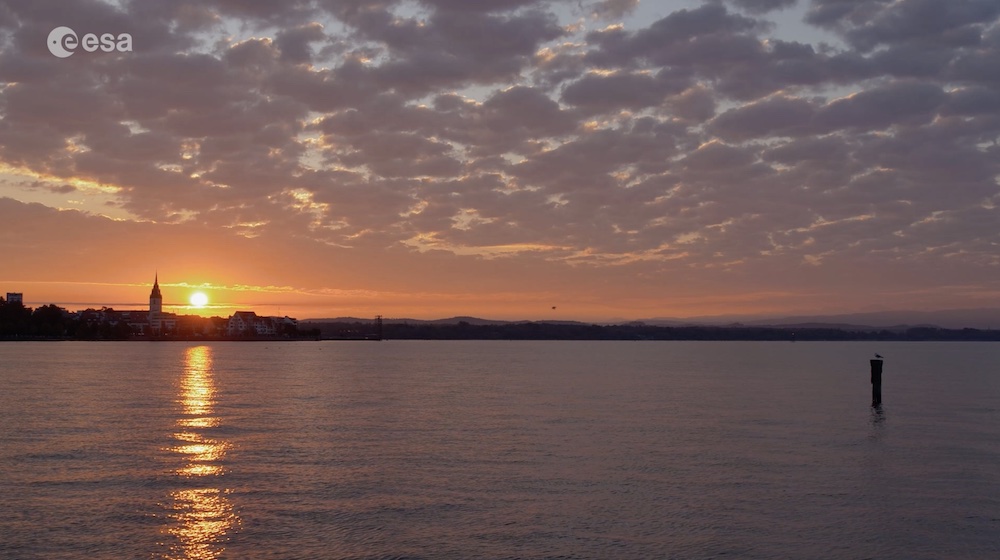
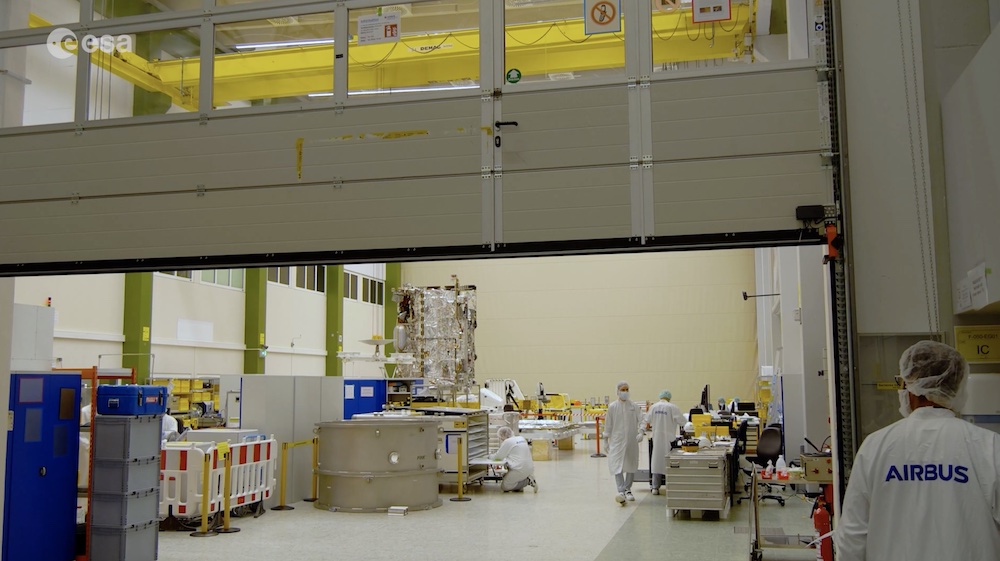
Later that morning, Hussein Seklawi, the Juice Floor Manager from Airbus, led the way into the clean room where Juice was being integrated. I managed to get my camera rolling just in time to film him pressing the button that opened the large vertical door to reveal Juice. It was my first real-life view of the spacecraft and I was deeply impressed. This shot is used more than once in episodes, the teaser to the final film and of course the final film itself.
The next spectacular moment was the transport of Juice from Friedrichshafen to ESTEC by road at the end of April 2021. Due to the size of the transport container, the truck was allowed to drive only at night. It took three nights to make the trip. I wanted to record the last leg from the southern border of the Netherlands to ESTEC. My science film colleague, Dan Brinkhuis, was kind enough to lend me his BMW Z4, and Oliver Witasse agreed to participate as my driver, glad of the chance to see the spacecraft transport first hand. In addition to filming on the road, I hired a professional drone team to film from the air. They obtained spectacular shots of the truck crossing over a large bridge in the south of the Netherlands and, finally, of the arrival of Juice in heavy rain at ESTEC at 3:30 in the morning!
Juice stayed at ESTEC for several months for the Thermal Balance Thermal Vacuum test campaign in the Large Space Simulator, during which I got a lot of great footage. Access to ESTEC was relatively easy for me and, by this time, I had become part of the Juice family in a way that people did not mind me being around – in fact they rather ignored me, like a fly on the wall, which led to authentic and natural footage. I even got to record a difficult moment of stress. This was a true gem, from a filmmaker’s point of view, with pure human interaction and no direction needed whatsoever.
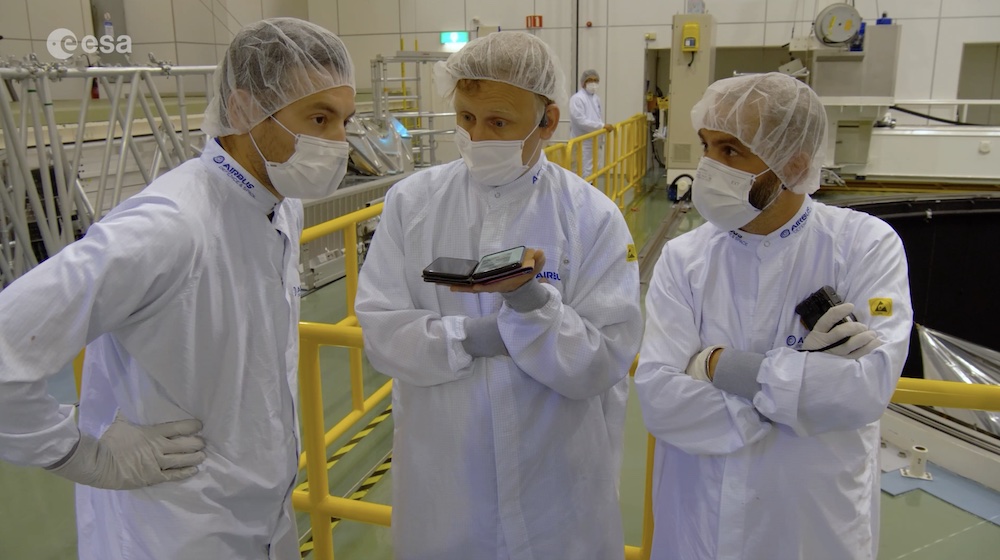
People from the Juice team at Airbus moved for lengthy periods of time to Noordwijk and its surroundings to work on Juice. This provided me with interesting opportunities to talk about the dynamic and varied lifestyle that is involved with making such a project. After three and a half months at ESTEC, Juice was moved to Toulouse to the Prime Contractor, Airbus, to be finished and shipped to Kourou for launch. This time the transport was done mostly by air. The Juice transport container, weighing some 18 tonnes in total, needed to be carried by an Antonov plane. We drove in one night to the closest airport where the Antonov was allowed to operate, Cologne/Bonn in Germany, and the next morning loaded the container. I was not allowed to film inside the Antonov. In any case, there were no windows in the passenger area and we had slept only one hour that night before, so were ready for a nap!
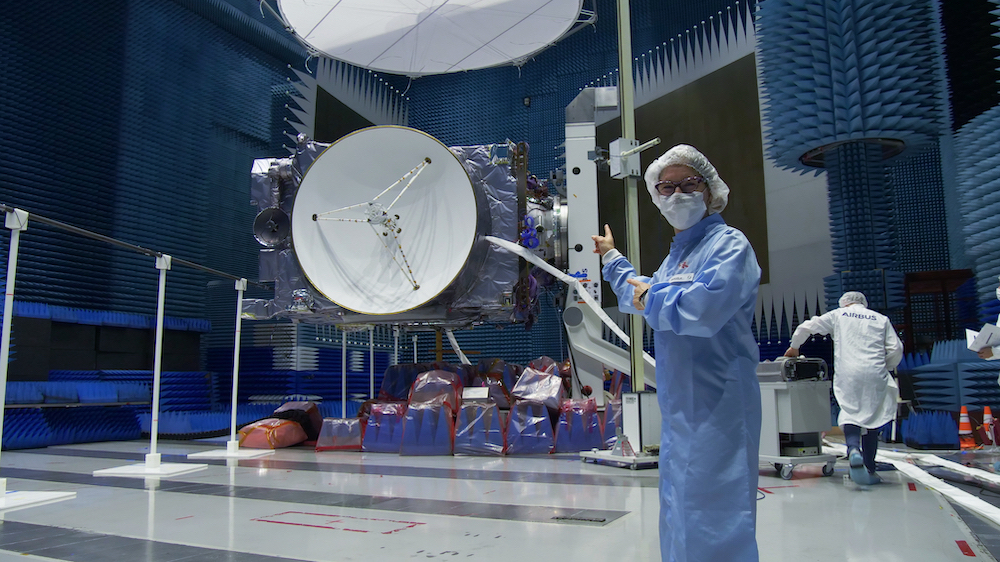
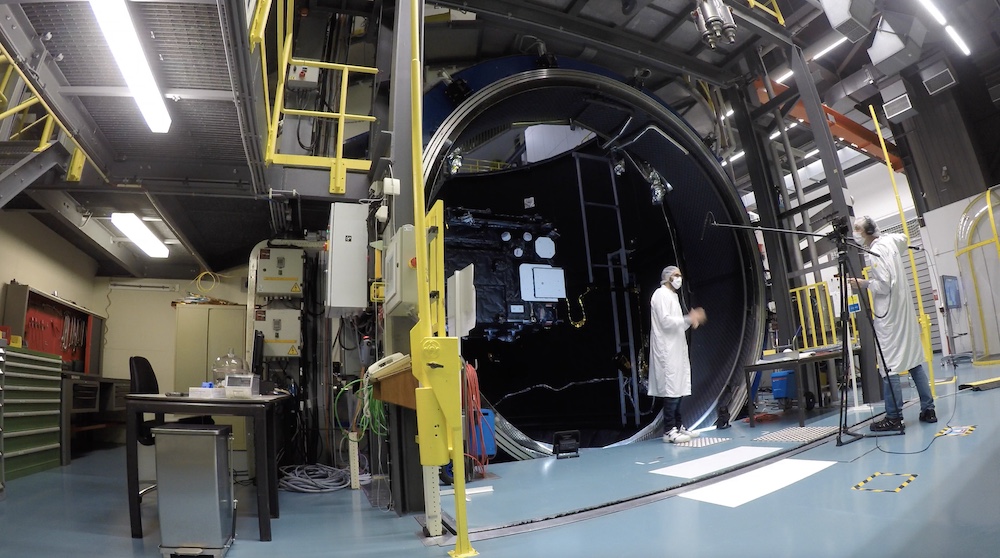
The work went on in Toulouse to integrate, test and prepare Juice for shipping to Kourou. However, delays partly due to the pandemic postponed the launch date to April 2023. I visited ESOC in Darmstadt to talk with the flight dynamics team, where I learned about the amazing art of designing trajectories and how the planetary scientist, Yves Langevin, had come up with an idea that saved travel time to Jupiter.
The Juice team wanted the mission to carry a tribute to Galileo, who in 1610 published the Sidereus Nuncius in which he described his discovery of four moons orbiting Jupiter. The idea was to engrave three pages of the book on a thin sheet of Single Layer Insulation (SLI) and attach that to the exterior of the spacecraft, which is covered in Multi Layer Insulation (MLI). To cover this story, I visited the Observatory of Rome in the autumn of 2022. Lucio Angelo Antonelli, the director of the Observatory, and his team kindly received me and explained details about the history while I filmed a copy of an early edition of the book. The engraved pages were installed on the spacecraft, together with another SLI containing a list of all the people from ESA, Airbus, industry and the science community who had contributed to the mission.
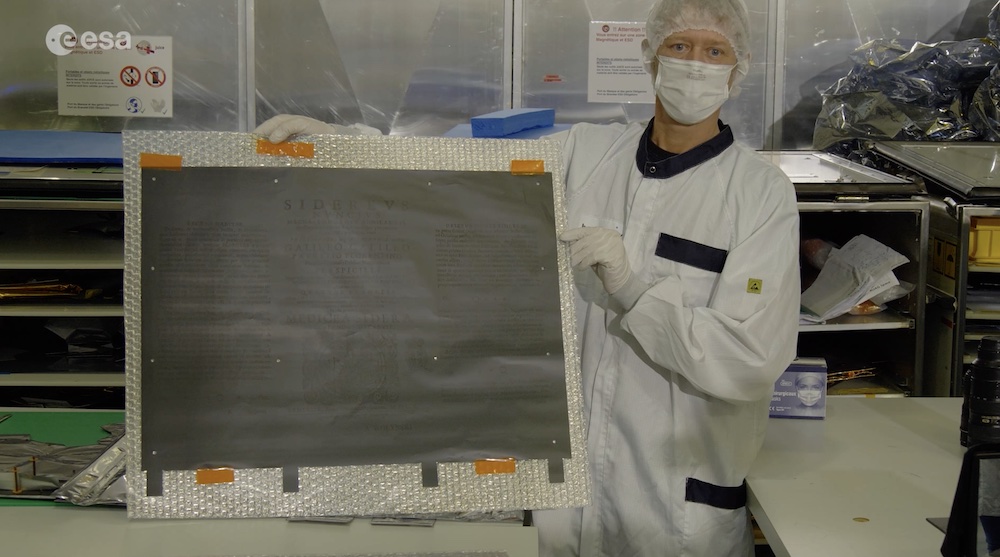
I wanted to film Galileo’s telescope as well. I contacted the Galileo Museum in Florence, only to find that I would have to pay 400 Euros for an hour of filming, plus a 1000 Euros security deposit! In the end, I found a very nice cardboard model for 25 Euros, with actual lenses. It was brilliant! My son Marco, a historian who somewhat resembles Galileo in his younger years, played the part of Galileo observing Jupiter.
At the end of 2022, a few months before launch, the first in-person Science Working Team meeting since the outbreak of the pandemic took place in Toulouse. It was the first time that I could meet most of the scientists in one place and interview some of them. This footage resulted in Episode 10, a three-part finale that covered Juice’s remote sensing, geoscience and in-situ science instruments.
Finally, the big day arrived. While I could not go to Kourou for the launch, Manuela Baroni from the Juice team filmed behind-the-scenes footage of all the activities there. I instead went to ESOC to witness the launch. A beautiful show was organised at ESOC, where some 200 people gathered. The first launch attempt failed due to weather conditions in Kourou – the disappointment, of course, was great for drama in the film! That evening I met a few of the Juice team members in a bar in Darmstadt. One of them said he could give me access to the Project Support Room to film from there. This is a room behind the Main Control Room. From here people from the mission follow the launch and support the team in the Main Control Room where necessary. This was truly behind the scenes, I think no-one ever filmed in that room! The moment of the launch arrived and it went beautifully. But launch is not all. Almost 50 minutes later, strong tension filled the air when Acquisition of Signal – the first contact between the spacecraft and the ground –did not seem to happen as expected. When it finally did, the relief was enormous – another great moment for the film!
Juice is on its way now and will arrive at Jupiter in July 2031. The film, The Making of Juice, is now available for viewing on the ESA YouTube channel. It gives a unique view of the making of that mission and the people behind it. I am very happy and honoured to have been able to create this film documenting a historical step in European planetary exploration.

